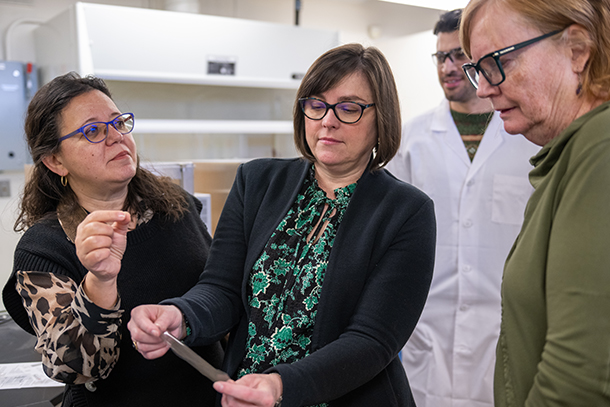
Project co-leads include Zoubeida Ounaies, director of the Convergence Center for Living Multifunctional Materials Systems, acting director of the Materials Research Institute and professor of mechanical engineering; Mary Frecker, professor of mechanical engineering and of biomedical engineering, head of Department of Mechanical Engineering and Reiss Chair of Engineering; and Lorraine Dowler, professor of geography and of women’s, gender and sexuality studies. Credit: Jeff Xu/Penn State
3D printing of medical devices focus of $2 million NSF grant
March 6, 2023
Editor’s note: A version of this press release appeared on The University of Texas at Austin’s site.
By Mary Fetzer
UNIVERSITY PARK, Pa. — Additive manufacturing technology, also known as 3D printing, provides the opportunity to create customized medical devices. However, the capabilities to design and print the smart, flexible materials this type of equipment requires remain lacking, according to researchers at Penn State and The University of Texas at Austin.
Those researchers are working to change that. A $2 million grant from the National Science Foundation (NSF)'s Leading Engineering for America’s Prosperity, Health and Infrastructure (LEAP-HI) program will pave the way for the researchers to tackle the challenge of designing and 3D printing smart devices using multiple materials.
“The project allows us to collaborate at the exciting intersection of advanced manufacturing, soft materials and adaptive structures,” said project co-lead Mary Frecker, professor of mechanical engineering and of biomedical engineering, head of Department of Mechanical Engineering and Reiss Chair of Engineering at Penn State. “The results will benefit patients by enabling shape change in medical devices.”
The researchers will work with Pennsylvania-based medical device company Actuated Medical Inc., which is led by Maureen Mulvihill, president and chief executive officer, who earned a doctorate of materials science and engineering from Penn State. Together, they plan to use 3D printing techniques to design pediatric ventilation masks and other medical devices that can be customized into different shapes during use.
They aim to pioneer new ways to print and actuate these multi-material devices, along with new methods for designing them, that take the capabilities of the additive manufacturing process into account and avoid expensive, iterative testing and refinement.
"With this grant we plan to take the capabilities of 3D printers to a new level of sophistication and automation," said project co-lead Carolyn Seepersad, professor at the Cockrell School of Engineering's Walker Department of Mechanical Engineering and faculty director at the Center for Additive Manufacturing and Design Innovation at UT Austin in a press release.
Leading the project with Frecker — who is also the director of the Penn State Center for Biodevices — and Seepersad are Penn State’s Zoubeida Ounaies, director of the Convergence Center for Living Multifunctional Materials Systems, acting director of the Materials Research Institute and professor of mechanical engineering; and Lorraine Dowler, professor of geography and of women’s, gender and sexuality studies.
The market for 3D printed medical devices is expected to reach $5.1 billion by 2026. But to achieve these expectations, additive manufacturing processes need to continue to improve.
Customization capabilities are imperative for many medical devices, and the ability to adjust their shape as the patient grows or heals is a game-changer. Finding a fast, cost-effective way to do that could make life a lot easier for patients and clinicians alike.
Though 3D printing has been around for several decades, few researchers have cracked the code on how to use additive manufacturing to create smart, multi-material objects and devices. The researchers envision printing smart devices that can change shape to accommodate shifting requirements, fabricating them in a single additive manufacturing process and customizing each device with a computationally efficient approach that ensures manufacturability.
“I am excited to work on this collaborative and truly multidisciplinary project,” Ounaies said. “It brings together materials science, mechanical engineering and social science and provides rich opportunities to innovate at the intersection of all these disciplines. I particularly look forward to working with all the students in this project as they too represent multiple expertise and disciplines.”
In addition to the technical goals of the project the researchers will chronicle how they think, collaborate and lead within their institutional structures to get a better understanding of diversity in engineering teams and projects.
“There have been numerous research studies that argue that diverse teams, both inherent — e.g., race, gender, sexuality — and acquired — e.g., education, geography, cultural background — lead to innovation,” said Dowler, who will document how diverse leadership leads to diverse results. “However, it is rare to have an opportunity to conduct a multi-year study that observes the day-to-day decision-making processes of diverse leadership and how that leads to both product innovation and job satisfaction for the entire team. The leadership team for this prestigious grant is all women, which, if not the first, is certainly rare in mechanical engineering.”



